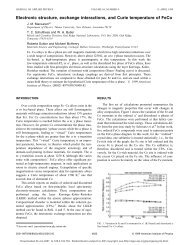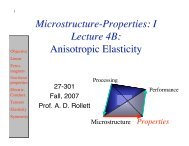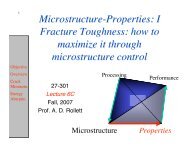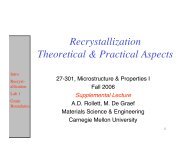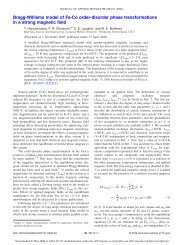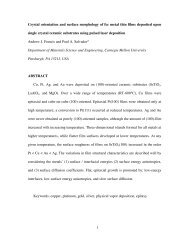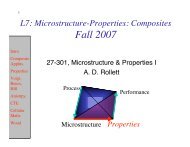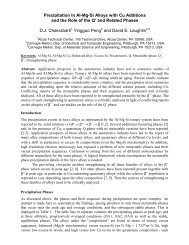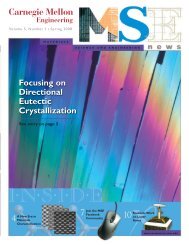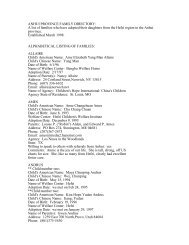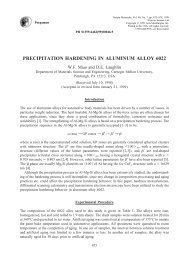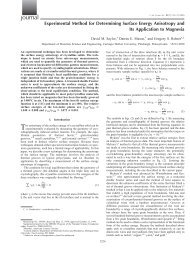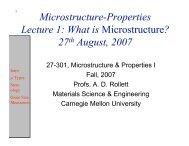Carnegie Mellon - Materials Science and Engineering - Carnegie ...
Carnegie Mellon - Materials Science and Engineering - Carnegie ...
Carnegie Mellon - Materials Science and Engineering - Carnegie ...
You also want an ePaper? Increase the reach of your titles
YUMPU automatically turns print PDFs into web optimized ePapers that Google loves.
<strong>Carnegie</strong> <strong>Mellon</strong><br />
<strong>Engineering</strong><br />
Volume 4, Number 1 • Spring 2007<br />
MATERIALS<br />
MSE Creates<br />
3D Images of<br />
Ni-Based<br />
Superalloys<br />
See story on page 3<br />
5MSE’s New<br />
Multifunctional<br />
Electronic<br />
<strong>Materials</strong> Center<br />
SCIENCE AND ENGINEERING<br />
6Solar Energy:<br />
An Ideal<br />
Alternative<br />
to Fossil Fuels<br />
8MSE’s Krzeminski<br />
Crowned National<br />
Champion<br />
www.materials.cmu.edu
A Note<br />
From the<br />
Department Head<br />
Gregory S. Rohrer,<br />
W.W. Mullins<br />
Professor<br />
2<br />
Dear MSE Graduates:<br />
As another academic year comes to a close, I will take this opportunity to report<br />
on the excellent health of the <strong>Materials</strong> <strong>Science</strong> <strong>and</strong> <strong>Engineering</strong> Department.<br />
First <strong>and</strong> most important, our undergraduate program continues to exp<strong>and</strong><br />
<strong>and</strong> succeed in producing excellent students. In 2001, our total undergraduate<br />
enrollment (in the sophomore, junior, <strong>and</strong> senior classes) was 43. Counting the 39<br />
students who have recently decided to join next year’s sophomore class, our total enrollment for<br />
the 2007/2008 academic year will be 94. As you can see in the Student News section, our undergraduates<br />
continue to receive recognition for their work. The majority of this year's graduates plan<br />
to follow in the footsteps of their predecessors <strong>and</strong> pursue higher degrees at the best engineering<br />
colleges in the country.<br />
Our graduate program also has good news. The College has made a major investment in<br />
graduate education by sponsoring the first year of tuition for all new doctoral students. The tuition<br />
fellowship includes an allowance so that each student can purchase a laptop computer for his or<br />
her thesis work. This investment has allowed us to exp<strong>and</strong> our graduate enrollment; this Fall, 22<br />
new doctoral students will join the Department, bringing the total number of doctoral students to<br />
more than 80.<br />
The faculty <strong>and</strong> staff remain busy <strong>and</strong> productive. During<br />
2006, each faculty member (on average) published eight<br />
papers, gave five invited lectures, <strong>and</strong> expended more than<br />
$400,000 in external funding, mostly to support graduate<br />
dissertation research. The faculty has also recently received<br />
external funding for large scale research instrumentation,<br />
including a dual-beam focused ion beam scanning electron<br />
microscope, a small-angle X-ray scattering system, a laser<br />
scanning multi-photon confocal microscope, <strong>and</strong> a robotized<br />
metallographic system with automated Laue pattern analysis<br />
for 3D microscopic studies. We will say more about each of<br />
these facilities in an upcoming issue of the newsletter.<br />
Finally, the Department recently resolved to work on two major initiatives for the future.<br />
The first is the renovation of the undergraduate facilities in Doherty Hall, including the teaching<br />
laboratories, the computer cluster, <strong>and</strong> student lounge area. We plan to modernize these facilities<br />
to accommodate both our evolving educational program <strong>and</strong> growing student body.The second<br />
is an expansion of our education <strong>and</strong> research programs in the area of materials for energy<br />
systems.This will include new course offerings <strong>and</strong> a Masters degree program.This effort will also<br />
involve research on materials that can operate in increasingly harsh conditions in conventional<br />
energy conversion systems, <strong>and</strong> materials with novel properties to be used in renewable energy<br />
conversion systems.<br />
Gregory S. Rohrer<br />
W.W. Mullins Professor <strong>and</strong> Department Head<br />
“ The majority of this<br />
year’s graduates plan to<br />
follow in the footsteps of<br />
their predecessors <strong>and</strong><br />
pursue higher degrees at<br />
the best engineering<br />
colleges in the country.<br />
”
cover story<br />
MSE Creates 3-D Images<br />
of Ni-Based Superalloys<br />
Quantitative analysis of three-dimensional microstructures in advanced engineering<br />
materials provides novel opportunities for the detailed characterization of<br />
individual precipitates <strong>and</strong>/or grains.<br />
A collaborative research group, including representatives of the Department of<br />
<strong>Materials</strong> <strong>Science</strong> <strong>and</strong> <strong>Engineering</strong>, is currently using a variety of serial-sectioning<br />
techniques to obtain 3D data, which is then further analyzed by means of image<br />
processing methods <strong>and</strong> statistical approaches. The alloy systems being studied by<br />
this group include two-phase a-b Ti alloys, as well as Ni-based superalloys. The cover<br />
image shows a 3D rendering of a single three-micron-wide g' precipitate in a<br />
Rene88-DT (damage-tolerant) superalloy; the color indicates the local mean<br />
surface curvature, from red (convex) to blue (concave).<br />
The input data for this 3D reconstruction was obtained by<br />
serial sectioning in a focused ion beam instrument at Wright<br />
Patterson Air Force Base by MSE graduate student<br />
Jeremiah MacSleyne, working with Michael Uchic of the<br />
Air Force Research Laboratory. The superalloy sample was provided by Tresa Pollock at the<br />
University of Michigan via Peter Sarosi at Ohio State University. The 3D reconstructions <strong>and</strong> image<br />
renderings were created by Professor Marc De Graef of MSE.<br />
Professor<br />
Marc De Graef<br />
Funding for this research was provided through the Office of Naval Research D3D project.<br />
Pittsburgh <strong>and</strong> CIT: A Winning Combination<br />
The city of Pittsburgh <strong>and</strong> <strong>Carnegie</strong> Institute of Technology (CIT) have recently won a long list of national<br />
awards <strong>and</strong> recognition—emphasizing what a unique combination of benefits are enjoyed by MSE faculty,<br />
staff, <strong>and</strong> students.<br />
Once again, Pittsburgh has been named “America’s Most Livable City” for 2007 by Places Rated Almanac,<br />
an honor the city last received in 1985. In addition, American Style magazine has named Pittsburgh its Best<br />
Arts Destination among mid-sized cities, <strong>and</strong> Forbes magazine recently recognized the region as among the<br />
top 10 “World’s Cleanest Cities.” An affiliate magazine of Financial Times named Pittsburgh one of North<br />
America’s top three “Cities of the Future,” <strong>and</strong> Expansion Management magazine ranked the city as one of<br />
America’s 50 hottest for business relocation <strong>and</strong> expansion. National Geographic Adventure magazine placed<br />
Pittsburgh at the top of its “America’s Best Urban Adventures” rankings.<br />
In addition, US News <strong>and</strong> World Report recently ranked <strong>Carnegie</strong> Institute of Technology sixth among US<br />
engineering schools in its 2008 ratings. Each year, the magazine assesses graduate programs at more than<br />
1200 major US universities, <strong>and</strong> ranks them according to their achievements in both research <strong>and</strong> education.<br />
3
faculty news<br />
Piehler Announces Retirement<br />
Professor<br />
Henry R. Piehler<br />
4<br />
In June, after 40 years of dedicated teaching <strong>and</strong> research,<br />
Professor Henry R. Piehler will officially retire.<br />
Piehler received his S.B. (1960), S.M. (1962), <strong>and</strong> Sc.D. (1967)<br />
degrees from Massachusetts Institute of Technology. He began his<br />
faculty career at <strong>Carnegie</strong> <strong>Mellon</strong> in 1967, <strong>and</strong> in 1974 he split<br />
his tenure between what were then known as the Metallurgy<br />
Department <strong>and</strong> the <strong>Engineering</strong> <strong>and</strong> Public Affairs Program—<br />
which later became the Department of <strong>Engineering</strong> <strong>and</strong><br />
Public Policy.<br />
Over the years, Professor Piehler’s research interests have been very diverse,<br />
focused on the areas of deformation processing <strong>and</strong> the mechanical behavior of materials—with<br />
special interests in powder <strong>and</strong> composites processing, sheet-metal formability<br />
<strong>and</strong> the properties of formed sheets, orthopedic <strong>and</strong> cardiovascular biomaterials<br />
<strong>and</strong> implants, powder metallurgy products, <strong>and</strong> composite <strong>and</strong> clad materials. He has<br />
also studied such issues as the interaction of law <strong>and</strong> technology in product-liability<br />
litigation, st<strong>and</strong>ardization processes, risk management, technology transfer, networking<br />
among engineers, productivity, <strong>and</strong> innovation.<br />
Piehler is a member of numerous societies <strong>and</strong> has served on many of their<br />
boards over the years. He has been the recipient of the George Tallman Ladd Teaching<br />
Award, the Bradley Stoughton Award for Young Teachers of Metallurgy, <strong>and</strong> the Award of<br />
Merit <strong>and</strong> Fellow of the American Society for Testing <strong>and</strong> <strong>Materials</strong>. He has authored or<br />
co-authored more than 95 publications.<br />
While he will be retiring, Piehler plans to remain actively involved in the<br />
Department—where we hope he will remain a presence for years to come.<br />
. . . . .<br />
MSE Research Associate Honored<br />
MSE Research Associate Dr. Michael Gao has received the APDIC Best Paper Award—<br />
presented by the Alloy Phase Diagram International Commission—for the best published<br />
manuscript on alloy phase diagram data in the year 2005. His paper, entitled<br />
“Reassessment of Al-Ce <strong>and</strong> Al-Nd Binary Systems Supported by Critical Experiments<br />
<strong>and</strong> First-Principles Energy Calculations,” was published in Metall. Mater. Trans. A (36A,<br />
2005, pp. 3269-3279). Co-authors of the paper are N. Unlu, G.J. Shiflet, M. Mihalkovic,<br />
<strong>and</strong> M. Widom. This paper was completed with partial financial support from the<br />
Computational <strong>Materials</strong> <strong>Science</strong> Network, a program of the Office of <strong>Science</strong>, US<br />
Department of Energy.<br />
FACULTY UPDATES<br />
Professor<br />
Mohammad F.<br />
Islam has received the<br />
CAREER Award from<br />
the National <strong>Science</strong><br />
Foundation (NSF)—<br />
which provides a fiveyear,<br />
$500,000 grant.<br />
Islam has also been named a recipient of<br />
the Sloan Research Fellowship. Both awards<br />
are intended to enhance the careers of the<br />
very best young faculty members in specified<br />
fields of science.<br />
. . . . .<br />
Professors Marc De Graef<br />
<strong>and</strong> Michael McHenry<br />
have authored a textbook<br />
entitled The Structure of<br />
<strong>Materials</strong>—An Introduction<br />
to Crystallography<br />
Diffraction <strong>and</strong> Symmetry.<br />
Publication by Cambridge is<br />
scheduled for July 2007. For details, visit<br />
http://som.web.cmu.edu.<br />
. . . . .<br />
Professor David E.<br />
Laughlin has been<br />
selected as a Fellow of<br />
TMS. Only a h<strong>and</strong>ful of<br />
TMS members are<br />
elevated to the class of<br />
Fellow each year. TMS<br />
Fellows are recognized<br />
for their outst<strong>and</strong>ing contributions to<br />
the practice of metallurgical science<br />
<strong>and</strong> technology.
Skowronski <strong>and</strong> Salvador Launch MEMC<br />
Center Will Foster <strong>Materials</strong> Innovations Through Collaborative Efforts<br />
MSE’s new Multifunctional Electronic <strong>Materials</strong> Center (MEMC)—led by Professors Marek<br />
Skowronski <strong>and</strong> Paul A. Salvador—is dedicated to developing new multifunctional electronic<br />
materials for use in data storage, electronics, communications, <strong>and</strong> energy technologies.<br />
MEMC’s multidisciplinary research focuses on developing <strong>and</strong> optimizing the processing techniques<br />
required to create or integrate advanced materials for these applications. The Center was created<br />
to continuously improve materials for current <strong>and</strong> near-term technologies—as well as develop<br />
materials that enable revolutionary changes in the functionality of electronic devices <strong>and</strong> systems.<br />
MEMC researchers are currently working to improve the storage density of memories, the<br />
reconfigurability of electronic processors, the tunability of high-frequency circuits in communications,<br />
<strong>and</strong> the electrocatalytic properties of cathodes in solid oxide fuel cells.This work is supported by<br />
collaborative research efforts with four well-established research centers:<br />
■ In cooperation<br />
with the Data<br />
Storage Systems<br />
Center (DSSC)<br />
at <strong>Carnegie</strong><br />
<strong>Mellon</strong>, MEMC<br />
is working to<br />
create new nanoscale devices that<br />
improve storage capacity on computer<br />
hard drives. Researchers are investigating<br />
heterostructures of complex oxides—<br />
one class of the so-called resistance<br />
change materials—to generate ultra-high<br />
density storage devices using novel nonvolatile<br />
electrically switchable domains<br />
controlled by arrays of miniature tips,<br />
called probes.<br />
■ Resistance change materials <strong>and</strong> probebased<br />
controls are also being developed<br />
with the Center for Memory Intensive<br />
Self-Configuring Integrated Circuits<br />
(MISC-IC) at <strong>Carnegie</strong> <strong>Mellon</strong>, in order<br />
to revolutionize the design of reconfigurable<br />
integrated circuits such as field<br />
programmable gate arrays. By employing<br />
materials-based programmable inter-<br />
connects in integrated circuits <strong>and</strong> using<br />
unique system architectures, designs for<br />
new reconfigurable integrated circuits are<br />
being developed—with applications that<br />
range from consumer iPods to large<br />
data/communications systems in military<br />
ships <strong>and</strong> planes.<br />
■ In partnership<br />
with the Penn<br />
State Electro-<br />
Optics Center<br />
(EOC), MEMC<br />
is developing<br />
tunable highfrequencyelectronic<br />
circuits that will improve the<br />
performance of wireless communications<br />
systems—for example, making radar<br />
systems more agile with respect to their<br />
sweeping rate. To accomplish this, MEMC<br />
researchers are improving the quality of<br />
thin films of complex oxides, designing<br />
prototype devices, <strong>and</strong> measuring<br />
materials <strong>and</strong> device characteristics in<br />
the MHz-GHz frequency ranges.<br />
■ MEMC is collaborating with the <strong>Materials</strong><br />
Research <strong>Science</strong> <strong>and</strong> <strong>Engineering</strong> Center<br />
(MRSEC) at <strong>Carnegie</strong> <strong>Mellon</strong>, as well<br />
as the National Energy Technology<br />
Laboratory (NETL), to improve the<br />
electrocatalytic performance of solid<br />
oxide fuel cells. Research is focused on<br />
underst<strong>and</strong>ing the surface activity of<br />
complex oxides, as well as preventing<br />
electrochemical degradation that arises<br />
from either long-term electrochemical<br />
poisoning or microstructural evolution.<br />
MEMC is supported by the direct participation<br />
of five professors, three post-doctoral<br />
research associates, <strong>and</strong> seven graduate<br />
research assistants. The Center’s research is<br />
also supported by more than $900,000 of<br />
annual funding provided by a range of<br />
sponsors that include the Semiconductor<br />
Research Corporation (SRC), Intel Corp.,<br />
the National <strong>Science</strong> Foundation (NSF),<br />
the Air Force Office of Sponsored Research<br />
(AFOSR), the Office of Naval Research<br />
(ONR), <strong>and</strong> the US Department of<br />
Energy (DOE).<br />
5
Solar Energy:<br />
An Ideal Alternative<br />
to Fossil Fuels<br />
By Professor Elias Towe <strong>and</strong><br />
Professor Lisa M. Porter<br />
Earth’s Atmosphere: A Delicate Balance<br />
Planet Earth is habitable because it has the right temperature <strong>and</strong><br />
atmosphere for sustaining life. Earth’s atmosphere acts as an insulating<br />
blanket—of optimal thickness, <strong>and</strong> possessing the right mix <strong>and</strong><br />
proportion of gases—for trapping solar energy. These insulating<br />
gases are called “greenhouse gases” because they keep heat on<br />
Earth, in a manner similar to a greenhouse.<br />
The main greenhouse gases, which are infrared active, are water<br />
vapor (H 2O), carbon dioxide (CO 2), methane (CH 4), <strong>and</strong> nitrous<br />
oxide (N 2O). Visible light from the Sun—absorbed by l<strong>and</strong>masses,<br />
oceans, <strong>and</strong> vegetation—is re-emitted as heat, in the form of<br />
infrared photons. This heat is absorbed by the greenhouse gases. The<br />
gas molecules, in turn, re-emit the heat, warming the atmosphere<br />
<strong>and</strong> Earth’s surface.<br />
This natural balance keeps the temperature on Earth at levels<br />
that sustain life. Altering the proportions of the greenhouse gases<br />
affects the amount of heat retained by the atmosphere—leading to<br />
global climate changes. Because burning fossil fuels produces carbon<br />
dioxide, CO 2 levels have risen from about 280 ppm in the preindustrial<br />
era to about 380 ppm today. This increase is largely attributed<br />
to the combustion of fossil fuels, <strong>and</strong> particularly to the emission<br />
of CO 2 [2]. Since the estimated residence time of CO 2 in the<br />
atmosphere is very long, identifying energy sources that do not produce<br />
CO 2 would help to preserve Earth’s delicate balance.<br />
Protecting the Balance:<br />
The Promise of Photovoltaic Energy<br />
In the face of potential atmospheric <strong>and</strong> climate changes, increasing<br />
attention is being paid to the Sun—a non-carbon-producing energy<br />
source. There are two approaches to harnessing solar energy: one<br />
relies on the thermal, or heating, effects of energy absorbed from the<br />
Sun, while the other—the photovoltaic effect—relies on the electron-generating<br />
effect of photons from the Sun.<br />
This article focuses on the potential of direct energy generation<br />
6<br />
Energy has recently become a topic of public discussion. This is partly due to the rising<br />
cost of fossil fuels, but primarily due to concern about major global climate changes<br />
that are likely to occur if pollution from CO 2 from fossil fuels is not curbed.<br />
It is the specter of these permanent negative consequences that is likely to force<br />
the world to ab<strong>and</strong>on fossil fuels—or to find more efficient ways of using them, which<br />
generate much less pollution. According to the World Energy Council, there is an<br />
abundance of fossil fuel reserves (coal, oil, <strong>and</strong> natural gas) to satisfy dem<strong>and</strong> in both<br />
the short <strong>and</strong> long terms [1]; scarcity is not an issue.<br />
via the photovoltaic effect, recognized for more than 50 years. The<br />
basic concept of photovoltaic energy involves the generation of electrons—in<br />
a solid semiconductor material—due to the absorption of<br />
light (photon) of a particular energy (wavelength or color). Associated<br />
with the generation of an electron is a “hole” left behind when that<br />
electron no longer occupies its original location. In the presence of an<br />
internal electric field, the electron <strong>and</strong> hole are attracted to opposite<br />
sides of the electric field vector in the semiconductor. This is known as<br />
transport by “drift”—the predominant mode of charge carrier collection<br />
in inorganic devices.<br />
Typically, the internal electric field is oriented perpendicular to the<br />
semiconductor surface, where, with appropriately placed metal electrodes,<br />
it enables the collection of the electron <strong>and</strong> hole as electric<br />
current. The internal electric field is usually designed into the semiconductor<br />
by special “dopants” in the material. This is the essence of the<br />
simple inorganic photovoltaic solar cell.<br />
The Limitations of Silicon<br />
Silicon has been, <strong>and</strong> remains, the major semiconductor used in photovoltaic<br />
solar cell panels—due to its abundance, as well as the ability<br />
to leverage the infrastructure of the global silicon microelectronics<br />
industry. Silicon, however, is not an ideal material for generating electricity<br />
from the Sun.<br />
The theoretical thermodynamic conversion efficiency limit for a<br />
simple silicon solar cell has been estimated to be about 30% [3], <strong>and</strong><br />
the measured record (unconcentrated) efficiency for a single-crystalline<br />
cell is about 24.7% [4]. The optimum photon energy required to<br />
“kick” an electron into circulation—as current, if it is collected—is<br />
about 1.1 eV in silicon, corresponding to a light wavelength (color) of<br />
about 1 μm, which is in the infrared. This energy is known as the b<strong>and</strong><br />
gap energy. Photons with more energy than this waste the remainder<br />
as heat, once the minimum energy required for electron-hole pair<br />
generation has been absorbed—<strong>and</strong> those with less energy do not<br />
contribute to the electron-hole pair generation process at all.
Researchers at CNXT are working on several<br />
approaches for creating multi-color solar cells<br />
based on inorganic <strong>and</strong> organic materials.<br />
Over 40% of solar energy is contained in the visible range of the<br />
electromagnetic spectrum; the majority of visible photons waste some<br />
energy as heat in silicon material. The figure at right illustrates the<br />
relative location of visible light in the solar energy spectrum, with the<br />
Sun considered as a blackbody source at 5800 K. Note that, beyond<br />
700 μm, the scale of the horizontal axis of the spectrum is logarithmic.<br />
A significant portion of the solar spectrum—slightly over 50<br />
percent—has photons with less energy than the b<strong>and</strong> gap of silicon;<br />
most of this portion therefore does not contribute to the solar<br />
electric power generation process in silicon.<br />
What is needed is a material whose energy structure allows the<br />
capture <strong>and</strong> conversion of a good fraction of the solar energy spectrum<br />
(rainbow). While no such materials exist in nature, the artificial<br />
structuring of some semiconductors through nanometer-scale<br />
engineering may allow their creation.<br />
CNXT: Focused on Next-Generation Solutions<br />
To overcome the limitations of silicon, researchers at the <strong>Carnegie</strong><br />
<strong>Mellon</strong> Center for Nano-Enabled Device <strong>and</strong> Energy Technologies<br />
(CNXT) are working on several approaches for creating multi-color<br />
solar cells based on inorganic <strong>and</strong> organic materials.<br />
With regard to inorganic materials, there are projects at CNXT<br />
exploring the use of engineered quantum nanostructures (quantum<br />
dots, quantum wires, <strong>and</strong> quantum wells) embedded in the active<br />
regions of compound semiconductor solar cell devices. There is particular<br />
interest in studying the use of epitaxially synthesized InGaAs<br />
quantum dots on GaAs substrates to create structures that allow<br />
absorption of solar energy at two or several distinct b<strong>and</strong>s of the<br />
spectrum. Since the b<strong>and</strong> gap of quantum dots can be modified by<br />
simply altering the size of the dots—or the composition of the dots<br />
<strong>and</strong> the matrix into which they are embedded—this approach could<br />
lead to higher conversion efficiencies.<br />
The InGaAs/GaAs materials system allows the tailoring of the<br />
absorption spectrum of quantum structures in the infrared. For the<br />
visible portion of the spectrum, the CNXT researchers plan to transfer<br />
the lessons learned to the InGaN/GaN materials system, where<br />
wider b<strong>and</strong> gap compositions can be created. CNXT research is also<br />
exploring more efficient light capturing <strong>and</strong> trapping methods, with the<br />
goal of enabling the manufacture of low-cost, high-efficiency solar cells.<br />
Going Organic: Solar Energy From a Surprising Source<br />
While much attention is focused on finding low-cost alternatives to silicon<br />
<strong>and</strong> other inorganic semiconductors, a major second-generation<br />
References<br />
[1] J. Trinnaman <strong>and</strong> A. Clarke (eds.), “20th World Energy Council Survey of Energy Resources,” http://www.worldenergy.org/wec-geis/publications/reports/ser04/foreword.asp.<br />
[2] S. Solomon, D. Qin, M. Manning, Z.Chen, M. Marquis, K.B. Averyt, M. Tignor, <strong>and</strong> H.L. Miller (eds.), “IPCC, 2007: Climate Change 2007:<br />
The Physical <strong>Science</strong> Basis—Contribution of the Working Group I to the Fourth Assessment Report on the Intergovernmental Panel on Climate Change,”<br />
Cambridge University Press, New York, NY (2007).<br />
[3] W. Shockely <strong>and</strong> H.J. Queisser, J. Appl. Phys., volume 32, pages 510-519 (1961).<br />
[4] M.A. Green, K. Emery, D.L. King, Y. Hishikawa, <strong>and</strong> W. Warta, Progress in Photovoltaics: Research <strong>and</strong> Applications, volume 14, pages 455-461 (2006).<br />
[5] A.J. Heeger, Rev. Modern Phys., volume 73, pages 681–700 (2001).<br />
[6] J. Liu, E. Sheina, T. Kowalewski, <strong>and</strong> R.D. McCullough, Angew<strong>and</strong>te Chemie, (International Edn.), volume 41, pages 329-332 (2002).<br />
[7] R.D. Schaller, M. Sykora, J.M. Pietryga, V.I. Klimov, Nano Letters, volume 6, pages 424-429 (2006).<br />
[8] S.A. McDonald, G. Konstantatos, S. Zhang, P.W. Cyr, E.D.J. Klem, L. Levina, <strong>and</strong> E. Sargent, Nature <strong>Materials</strong>, volume 4, pages 138-142 (2005).<br />
Energy (J/m 2 µm)<br />
1<br />
1<br />
Wavelength (µm)<br />
1 1<br />
Solar spectrum, with the Sun modeled<br />
as a perfect blackbody at 5800 K<br />
technology is based on a somewhat surprising material: polymers, or<br />
plastics. Although typically insulating, certain polymers can be made<br />
conductive through controlled synthesis <strong>and</strong> processing [5, 6].<br />
Moreover, because polymers can be processed from solution rather<br />
than via the expensive deposition processes required to manufacture<br />
silicon <strong>and</strong> other inorganic semiconductors, organic solar cells could<br />
be made at a much lower cost than their inorganic counterparts.<br />
Furthermore, their flexibility would allow for roll-to-roll processing,<br />
much like photographic film. There is also the potential to easily<br />
incorporate them into structures such as clothing or buildings.<br />
MSE faculty members are collaborating with colleagues in the<br />
Department of Chemistry to create solar cells that combine organic<br />
materials blended in composite form at the nanometer scale. In this<br />
application, nanotechnology is a critical development that enables the<br />
positive <strong>and</strong> negative charges to be separated <strong>and</strong> extracted as current.<br />
This team is working to optimize the nanometer-scale morphology<br />
of the materials, as well as developing novel processing methods<br />
that would lead to low-cost manufacturing.<br />
Diverse Approaches—With a Shared Goal<br />
Researchers elsewhere are pursuing different approaches to making<br />
solar cells through nanotechnology. For example, at the National<br />
Renewable Energy Laboratory, scientists are studying the use of colloidal<br />
quantum dots prepared inexpensively in solution. They have<br />
conducted experiments with the dots that demonstrate that a single<br />
photon could generate several electron-hole pairs, indicating potential<br />
conversion efficiencies well beyond 100% [7]. No solar cells with this<br />
characteristic have yet been demonstrated.<br />
Story continued on page 10 ☛<br />
7
student news Damage of Structural <strong>Materials</strong> VI. The conference<br />
was sponsored by the International<br />
Doctoral student Lisa<br />
Chan won the Light<br />
Metals Division Graduate<br />
Student Poster Contest<br />
at the 2007 TMS Annual<br />
Meeting & Exhibition.<br />
The title of her poster<br />
Lisa Chan was “The Effect of Grain<br />
Boundary Character Distribution on the<br />
Stress Corrosion Cracking Susceptibility of<br />
2124 Aluminum Alloy.”<br />
. . . . .<br />
Doctoral student<br />
Stephen D. Sintay<br />
(with R. Campman, G.<br />
Welsh, E.L. Anagnostou,<br />
J.M Papazian, <strong>and</strong> A.D.<br />
Rollett) was recognized<br />
with the Best Poster<br />
Stephen D. Sintay of the Conference Award<br />
for “Grain Orientation Influence on Matrix<br />
Crack Initiation in AA7075-T651,” during<br />
the International Conference on Fatigue<br />
Krzeminski Crowned<br />
National Champion<br />
MSE senior David Krzeminski won the national<br />
championship in the 200-yard butterfly at the NCAA<br />
Division III National Swimming Championships in<br />
Houston, Texas, on March 17.<br />
In the championship’s final heat, Krzeminski topped<br />
his preliminary time—touching the wall with a time of<br />
1:49.54—to set a new school record. He becomes<br />
<strong>Carnegie</strong> <strong>Mellon</strong>’s sixth national champion in the last five<br />
years, as well as the first to win a national crown since<br />
Chris Pearson won the 200-yard freestyle <strong>and</strong> 200-yard<br />
butterfly in 2005. Krzeminski is a six-time All-American.<br />
8<br />
Journal of Fatigue.<br />
. . . . .<br />
Doctoral student Herbert M. Miller<br />
won a National <strong>Science</strong> Foundation (NSF)<br />
supported Travel Fellowship to attend the<br />
European Ceramic Society meeting in<br />
Berlin, Germany, in June. He will present a<br />
paper titled “Time Evolution of the Grain<br />
Boundary Character Distribution During<br />
Grain Growth in Strontium Titanate.”<br />
. . . . .<br />
A number of MSE students<br />
were honored this<br />
spring at the ASM<br />
International Young<br />
Members Night<br />
(Pittsburgh Golden<br />
Triangle Chapter). In the<br />
Paul Ohodnicki graduate student poster<br />
competition, doctoral student Shengyu<br />
Wang was awarded first place, <strong>and</strong> doctoral<br />
student Paul Ohodnicki was<br />
awarded third place. Seniors Ruby Chen<br />
<strong>and</strong> Nicole Hayward took third place<br />
in the undergraduate student poster competition.<br />
Sophomore Steve Spurgeon was<br />
awarded the Past Chairman’s Educational<br />
Assistance Award, while Nicole Cates<br />
received the Outst<strong>and</strong>ing College Senior Award.<br />
. . . . .<br />
Junior Sophia<br />
Woodley was the 2006<br />
recipient of the Boeing<br />
Scholarship for Academic<br />
Leadership. She was<br />
selected because she<br />
possesses the characteris-<br />
Sophia Woodley tics that Boeing values<br />
in c<strong>and</strong>idates: leadership, teamwork, <strong>and</strong><br />
academic excellence.<br />
. . . . .<br />
Senior Eric V<strong>and</strong>erson received the<br />
GE Co-Op/Intern Corporate Award, which is<br />
given to approximately 3% of GE interns<br />
worldwide. The award was based on work<br />
V<strong>and</strong>erson did as a co-op in summer<br />
2006, which led to over $2.9 million in<br />
annual savings for GE.
Junior Rebecca Snyder<br />
received a second-place<br />
prize for her poster<br />
titled “Use of Ferrogels<br />
to Improve Catheter<br />
Navigational Control:<br />
Neurointerventional<br />
Rebecca Snyder Radiology-Based<br />
Applications.” The poster session was part<br />
of the <strong>Carnegie</strong> <strong>Mellon</strong> course, Surgery for<br />
<strong>Engineering</strong>, <strong>and</strong> was attended by many local<br />
physicians <strong>and</strong> surgeons.<br />
MSE seniors Nicole<br />
Cates <strong>and</strong> Esther Yu<br />
have both been awarded<br />
prestigious NSF Graduate<br />
Fellowships. NSF awards<br />
approximately 1,000<br />
graduate fellowships per<br />
Nicole Cates year, in keeping with its<br />
mission to ensure the<br />
vitality of the human<br />
resource base of science,<br />
technology, engineering,<br />
<strong>and</strong> mathematics in the<br />
US—as well as to reinforce<br />
its diversity. These<br />
Esther Yu fellowships provide three<br />
years of support for graduate study leading<br />
to research-based masters or doctoral<br />
degrees. The Graduate Research Fellowship<br />
Program (GRFP) invests in graduate education<br />
for a range of diverse individuals who<br />
demonstrate their potential to successfully<br />
complete graduate degree programs.<br />
This fall, Yu will begin doctoral studies in<br />
the Bioengineering Department at the<br />
University of Pennsylvania, while Cates will<br />
pursue her doctoral degree in <strong>Materials</strong><br />
<strong>Science</strong> <strong>and</strong> <strong>Engineering</strong> at Stanford<br />
University.<br />
MSE Gets a Facelift<br />
I<br />
n the summer of 2006, the Department of <strong>Materials</strong> <strong>Science</strong> <strong>and</strong> <strong>Engineering</strong> gave<br />
its Wean Hall corridors a much-needed renovation. Gone are the dismal <strong>and</strong><br />
depressing gray concrete walls <strong>and</strong> floors. Each hallway received a bright coat of paint,<br />
modern flooring, <strong>and</strong> new signage. The change is refreshing—<strong>and</strong> MSE is now the envy<br />
of Wean Hall!<br />
Before<br />
RECENT PH.D. THESES<br />
Tricia Bennett<br />
“Abnormal Grain Growth in Fe-1%Si”<br />
ADVISOR: Anthony D. Rollett<br />
Nan Boonyachut<br />
“The Cellular Transformation in Cu-Ti<br />
Age-Hardening Alloys”<br />
ADVISOR: David E. Laughlin<br />
Daniel J. Ewing<br />
“Inhomogeneities <strong>and</strong> Their Effect on the<br />
Electrical Characteristics of Schottky<br />
Contacts to n-Type 4H-SiC”<br />
ADVISOR: Lisa M. Porter<br />
Sungwook Huh<br />
“Deep Level Defects in SiC Crystals<br />
Grown by Halide CVD Method”<br />
ADVISOR: Marek Skowronski<br />
Pallav Kaushik<br />
“Mixed Burden Softening <strong>and</strong> Melting<br />
Phenomena”<br />
ADVISOR: Richard J. Fruehan<br />
Balasubramaniam R. Kavaipatti<br />
“Phase Competition <strong>and</strong> Thin Film Growth<br />
After<br />
of Layered Ferroelectrics <strong>and</strong> Related<br />
Perovskite Phases”<br />
ADVISOR: Paul A. Salvador<br />
Paolo Nolli<br />
“Initial Solidification Phenomena: Factors<br />
Affecting Heat Transfer in Strip Casting”<br />
ADVISOR: Alan W. Cramb<br />
Changyong Um<br />
“Fe-Based Amorphous <strong>and</strong> Nanocrystalline<br />
Nanocomposite <strong>Materials</strong>”<br />
ADVISOR: Michael E. McHenry<br />
Martín E. Valdez<br />
“Controlled Undercooling of Liquid Iron: Effect<br />
of Substrate Composition <strong>and</strong> Undercooling”<br />
ADVISORS: Sridhar Seetharaman <strong>and</strong><br />
Alan W. Cramb<br />
Sai Prasanth Venkateswaran<br />
“Domain Structure Investigations in Multiferroic<br />
Heusler Ferromagnetic Shape Memory Alloy”<br />
ADVISOR: Marc De Graef<br />
Wanlin Wang<br />
“The Heat Transfer Phenomenon Across<br />
Moldflux to Copper Mold in Continuous Casting”<br />
ADVISOR: Alan W. Cramb<br />
9
department news<br />
New Multidisciplinary<br />
Course Makes Its Debut<br />
Diverse Students Join to Assess Steel<br />
<strong>and</strong> Wood Construction<br />
The Fall 2006 semester marked an exciting new<br />
addition to the MSE curriculum when Associate<br />
Teaching Professor Robert Heard joined<br />
with Research Associate Deanna H. Matthews (Civil <strong>and</strong><br />
Environmental <strong>Engineering</strong>) to co-teach an innovative project<br />
course. “Environmental Life Cycle Assessment of Steel <strong>and</strong><br />
Wood in Construction” brought together a diverse group of<br />
students from across the University—with the common goal<br />
of comparing the environmental impacts of these two<br />
Professor Robert Heard<br />
building materials.<br />
The new course—supported by a FeMet Grant from the Association for Iron<br />
<strong>and</strong> Steel Technology (AIST)—attracted students from MSE, as well as the School of<br />
Design <strong>and</strong> the Department of Civil <strong>and</strong> Environmental <strong>Engineering</strong>. Each student<br />
contributed his or her own academic experience <strong>and</strong> talents to the project work,<br />
while learning from those in other disciplines. This collaborative experience showed<br />
students how disciplines interact in real-world projects, as well as encouraging them<br />
to pursue their own interests within the topic area.<br />
The collaborative student team performed a thorough assessment of steel<br />
products as either a direct replacement for wood products in construction applications,<br />
or as newly designed products. Their work included an environmental life<br />
cycle assessment (LCA) that focused on energy consumption <strong>and</strong> greenhouse gas<br />
emissions as metrics.<br />
The life cycle assessment involved a hybrid approach of both process-based<br />
analysis of materials manufacturing <strong>and</strong> an economic input-output analysis (EIO-LCA)<br />
of the supply chain. Data was collected on specific processes within the products’ life<br />
cycle, including the extraction of raw materials, the manufacturing of steel <strong>and</strong> wood<br />
semi-finished products, <strong>and</strong> the final finishing of these products.<br />
“The results of this new project course provide an invaluable comparison of steel<br />
<strong>and</strong> wood construction products from an environmental perspective,” notes Professor<br />
Heard. “We hope that this careful examination of the environmental life cycle impacts<br />
of steel <strong>and</strong> wood products will help to identify areas where steel is a viable alternative<br />
for wood—<strong>and</strong> merits inclusion in green building construction.”<br />
10<br />
Solar Energy<br />
Continued from page 7<br />
Other researchers have embedded the<br />
colloidal dots in organic semiconductor polymer<br />
materials. The basic idea is to sensitize a<br />
conjugated polymer, such as poly[2-methoxy-<br />
5-(2'-ethylhexyloxy-p-phenylenevinylene)]<br />
(MEH-PPV), by inserting colloidal dots of the<br />
right size for particular spectral absorption<br />
b<strong>and</strong>s into the active region of the MEH-PPVbased<br />
device. Although solar cell devices<br />
manufactured using this approach still have a<br />
long way to go—with demonstrated efficiencies<br />
below 1%—their main attraction is the<br />
potential for low-cost manufacturing [8].<br />
Looking beyond environmental impacts <strong>and</strong><br />
climate change, the one overarching factor that<br />
would accelerate the adoption of photovoltaic<br />
technology is a lower cost per unit of energy.<br />
Two short-term scenarios are likely: either a<br />
low-cost technology with solar cell panels of<br />
moderate conversion efficiencies (10-15%)<br />
will lead to large-scale deployment, or a moderate-cost<br />
technology with solar cell panels of<br />
high conversion efficiencies (30-50%) will be<br />
deployed. These two approaches are considered<br />
second- <strong>and</strong> third-generation photovoltaics,<br />
respectively, as opposed to today’s<br />
first-generation, silicon-based photovoltaics.<br />
In either case, the unit cost of energy should<br />
reach a threshold that is almost competitive<br />
with the unit cost of traditional energy sources.<br />
Thanks to nanotechnology, we believe the<br />
future looks bright for solar cells—as well as<br />
for the ongoing efforts to protect Planet Earth.<br />
the authors<br />
Professor Elias Towe Professor Lisa M. Porter
alumni news<br />
Diane Albert<br />
(M.S. ’87, Ph.D. ’91), a<br />
recent graduate of the<br />
University of New<br />
Mexico School of Law,<br />
has been honored as a<br />
pioneer of The Ohio<br />
State University’s<br />
College of <strong>Engineering</strong>,<br />
where she earned her B.S in 1982. Albert<br />
was recognized this spring during Ohio<br />
State’s first “Honoring Women in STEMS”<br />
event. The event acknowledges <strong>and</strong> honors<br />
the many women within the University<br />
who have obtained a Ph.D. in science,<br />
technology, engineering, or math (STEM).<br />
Albert received her J.D. degree this spring.<br />
. . . . .<br />
Bassem El-Dasher (M.S. ’98, Ph.D. ’03)<br />
recently accepted a Metallurgist position in<br />
the <strong>Materials</strong> <strong>Science</strong> <strong>and</strong><br />
<strong>Engineering</strong> Division at<br />
Lawrence Livermore<br />
National Laboratory. This<br />
Division is part of the<br />
Chemistry, <strong>Materials</strong>, <strong>and</strong><br />
Life <strong>Science</strong>s Directorate.<br />
. . . . .<br />
Diane Albert Bassem El-Dasher Roberto J. Rioja<br />
Thomas Gilbert (B.S. ’98) recently completed<br />
his Ph.D. in Bioengineering at the<br />
University of Pittsburgh, <strong>and</strong> has accepted<br />
a Research Assistant Professor position<br />
there in the Department of Surgery.<br />
Gilbert has also been advising students<br />
in MSE’s Capstone Design course on<br />
projects related to the use of materials in<br />
biomedical applications.<br />
. . . . .<br />
Roberto J. Rioja (M.S. ’77, Ph.D. ’79) was<br />
elected a Fellow of ASM’s Class of 2006. His<br />
George A. Roberts (B.S. ’39, M.S. ’41, Ph.D. ’42) has penned<br />
a memoir of the Teledyne Corporation <strong>and</strong> the man who<br />
created it. Roberts met Henry Singleton when they were<br />
first-year students <strong>and</strong> roommates at the US Naval Academy<br />
at Annapolis in 1935—beginning a lifelong friendship, as<br />
well as more than three decades of a close <strong>and</strong> remarkably<br />
productive business association. Distant Force, a new<br />
book by Roberts (with former <strong>Carnegie</strong> <strong>Mellon</strong> president<br />
Robert Mehrabian) is his memoir of how they built the<br />
Teledyne Corporation into a $4 billion business<br />
that was, at times, controversial—but also unerringly<br />
successful in providing high financial returns<br />
to those shareholders who remained with them<br />
through their amazing journey. For more<br />
information on Distant Force, please visit<br />
http://www.distantforce.com.<br />
Tomoko Sano<br />
Mitra Taheri<br />
citation reads, “For distinguished<br />
contributions to<br />
the development of new<br />
aluminum products to<br />
meet the increasingly<br />
dem<strong>and</strong>ing requirements<br />
of the aerospace <strong>and</strong> space<br />
industries.” Rioja works at<br />
Alcoa as a Technical<br />
Manager.<br />
. . . . .<br />
Tomoko Sano (M.S.<br />
’01, Ph.D. ’05) is currently<br />
a <strong>Materials</strong> Engineer in<br />
the <strong>Materials</strong> Division,<br />
Survivability <strong>Materials</strong><br />
Branch, at the US Army<br />
Research Lab.<br />
. . . . .<br />
Mitra Taheri (B.S ’01,<br />
M.S. ’02, Ph.D. ’05) has<br />
been named the<br />
Hoeganeas Professor<br />
of Metallurgy at<br />
Drexel University.<br />
We love hearing from our<br />
graduates! If you would like to be<br />
included in the next issue of MSE<br />
News, simply send your update to<br />
sb3n@<strong>and</strong>rew.cmu.edu, or<br />
mail it directly to the Department c/o<br />
Alumni Updates.<br />
11
Department of<br />
<strong>Materials</strong> <strong>Science</strong><br />
<strong>and</strong> <strong>Engineering</strong><br />
<strong>Carnegie</strong> <strong>Mellon</strong> University<br />
Pittsburgh, PA 15213-3890<br />
Department Head<br />
Gregory S. Rohrer<br />
Editor<br />
Suzanne B. Smith<br />
Photographers<br />
Ken Andreyo<br />
Glenn Brookes<br />
Martin Santek<br />
Designer<br />
Dan Hart<br />
<strong>Carnegie</strong> <strong>Mellon</strong> University does not discriminate <strong>and</strong> <strong>Carnegie</strong> <strong>Mellon</strong> University is<br />
required not to discriminate in admission, employment, or administration of its programs<br />
or activities on the basis of race, color, national origin, sex, or h<strong>and</strong>icap in violation of<br />
Title VI of the Civil Rights Act of 1964, Title IX of the Educational Amendments of 1972,<br />
<strong>and</strong> Section 504 of the Rehabilitation Act of 1973, or other federal, state, or local laws or<br />
executive orders.<br />
In addition, <strong>Carnegie</strong> <strong>Mellon</strong> University does not discriminate in admission, employment,<br />
or administration of its programs on the basis of religion, creed, ancestry, belief, age,<br />
veteran status, or sexual orientation, or in violation of federal, state, or local laws or executive orders. However,<br />
in the judgment of the <strong>Carnegie</strong> <strong>Mellon</strong> Human Relations Commission, the Department of Defense policy of<br />
“Don’t ask, don’t tell, don’t pursue” excludes openly gay, lesbian, <strong>and</strong> bisexual students from receiving ROTC<br />
scholarships or serving in the military. Nevertheless, all ROTC classes at <strong>Carnegie</strong> <strong>Mellon</strong> University are available<br />
to all students.<br />
Inquiries concerning application of these statements should be directed to the Provost, <strong>Carnegie</strong> <strong>Mellon</strong><br />
University, 5000 Forbes Avenue, Pittsburgh, PA 15213, telephone (412) 268-6684, or to the Vice President for<br />
Enrollment, <strong>Carnegie</strong> <strong>Mellon</strong> University, 5000 Forbes Avenue, Pittsburgh, PA 15213, telephone (412) 268-2056.<br />
Obtain general information about <strong>Carnegie</strong> <strong>Mellon</strong> University by calling (412) 268-2000.<br />
<strong>Carnegie</strong> <strong>Mellon</strong> University publishes an annual campus security report describing the University’s security,<br />
alcohol <strong>and</strong> drug, <strong>and</strong> sexual assault policies, <strong>and</strong> containing statistics about the number <strong>and</strong> type of crimes<br />
committed on the campus during the preceding three years. You can obtain a copy by contacting the <strong>Carnegie</strong><br />
<strong>Mellon</strong> Police Department at (412) 268-2323. The security report is also available at www.cmu.edu/security.<br />
<strong>Carnegie</strong> <strong>Mellon</strong> University makes every effort to provide accessible facilities <strong>and</strong> programs for individuals with<br />
disabilities. For accommodations/services, please contact the Equal Opportunity Office at (412) 268-2012.



